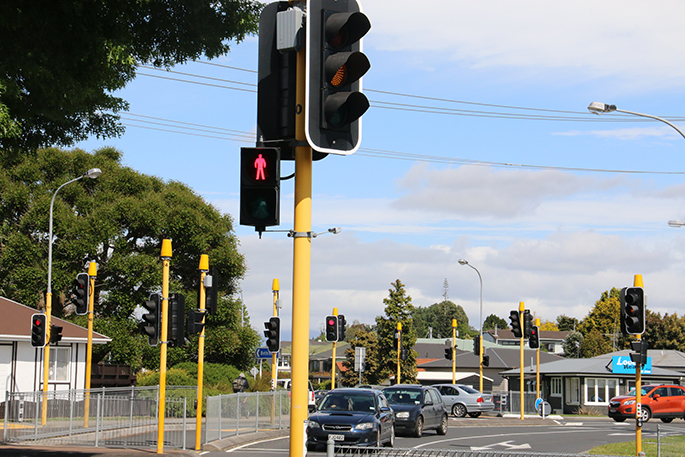Christchurch started it. And Tauranga finished it.
It's about traffic lights and one-upmanship.
In the Garden City they have been saying 'kinda overkill”, questioning the need for 19 traffic light poles to control just one intersection in their CBD whereas before the earthquakes there was none. That's $8,500 for each of 19 poles to control a meeting point of trams, cycles, pedestrians and vehicles.
If it was a contest, Tauranga would win. With piles of traffic standards to spare.
'Tauranga has plenty of intersections where we have at least 20 traffic lights,” says Haydn Wardley, the go to man about traffic lights at the Tauranga Traffic Operations Centre. 'And another one in Rotorua which we also look after.”
Then there's Haydn's red, yellow and green magnum opus – his own grand design, the Brookfield lights, thirty five poles and many more lights, scattered strategically of course, over a sprawling piece of suburban real estate claimed by cars.
'Thirty-six poles actually,” corrects Haydn.
He should know. He designed and strategically placed each pole, sweated for six months to bring some order and flow to the chaos that had been the Brookfield interchange. There's the convergence of a whole lot of roads, there are many residences, multiple driveways, a shopping centre with four or five access ways in and out, there's a school and there are pedestrians. 'The peanut-about,” says Haydn. 'A roundabout with an intersection on the side – shaped like a peanut.”
When he saw Brookfield for the first time, when he took on board all the complications it was a ‘bloody hell' moment. 'Very much so because of the tight land restrictions. We would have had to buy up enormous numbers of houses to get a normal intersection in there. Cost implications and the land – it was an impossible task actually.”
The engineer still can't believe what he managed to do. 'We saved millions on that build, a separated intersection would have cost five times as much.”
There were lots of different designs. ”But the biggest problem was convincing people, convincing everyone that I was right,” says Haydn. Self-assured but there were a lot of sleepless nights.
'You design it on paper, you go on site a lot and then you tweak things and change them again. Brookfield was about getting it absolutely right, getting it perfect.” Does he think he nailed it? 'Yes, very much so. People really like it. They are gob smacked because they know what we have resolved.”
Not everyone though. One local likened Brookfield to the outcome of a birthday party where sugared-up, blind-folded kids played pin the traffic light on the intersection. The engineer did field a lot of questions and a lot of complaints. 'But it was a ‘dog' beforehand and afterwards people couldn't believe how well it was running.” Says Haydn. And it still does today.” Three sets of red, yellow and greens in every direction of every lighted segment of the interchange. Many standards and many, many lights.
'That's the rules, they have to be clearly visible to the driver, a minimum of three but you can have four or five.”
And those lighted segments are jammed in. 'Everything is so close, you are sitting on a stop line and wondering about the lights in front of you. Are they for me or are they for you?” So it's been designed ergonomically - some of the lanterns have been twisted slightly so they can't easily be seen from a side view. Only if you turn your head. And again, for drivers looking straight ahead, the lights have been reconfigured downwards so any confusion is minimised.
Which is why the Brookfield and two others of Haydn Wardley's babies are unique in New Zealand.
The phasing of lights at all other intersections are regulated by sensors in the road. They are triggered by the metal in vehicles and change depending on the flow of traffic. Not Brookfield, Maungatapu and Welcome Bay. They are programmed for a specific time of the day, morning peak time, lunchtime, afterschool and it doesn't change.
'They only know it's four o'clock or whatever o'clock and will run a certain sequence. So it's fixed.”
It's designed that way because there's only so much room behind each stop line. 'I only want (the phase) to run ten seconds, I don't want the signals to give any more time.” Otherwise the traffic backs up and clogs the intersection. Or there can be traffic from one section still clearing the junction when the next stage starts, increasing the likelihood of collisions.
This way the traffic is systematically moved through the intersection, there is always part of the intersection running on green in short phases, rather than the whole intersection going on pause. And the traffic is 'spat out” on the other side.
But it may well be time for more ‘tweaking.' Brookfield is now seven years old, the city is burgeoning and there's new pressure. 'We have all noticed new congestion there so I am looking at changing the fixed times. Very soon.”
And when he retires Haydn Wardley will look back on Brookfield intersection with professional pride. 'Very much so.” He unraveled a nasty traffic snarl, saved the ratepayer much money, and the motorist time, agro and accidents.

